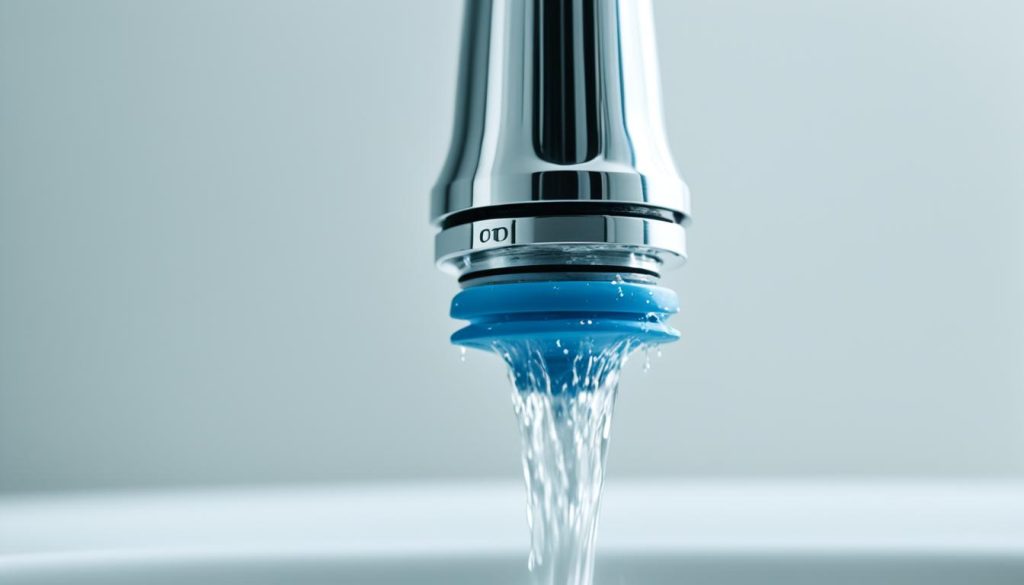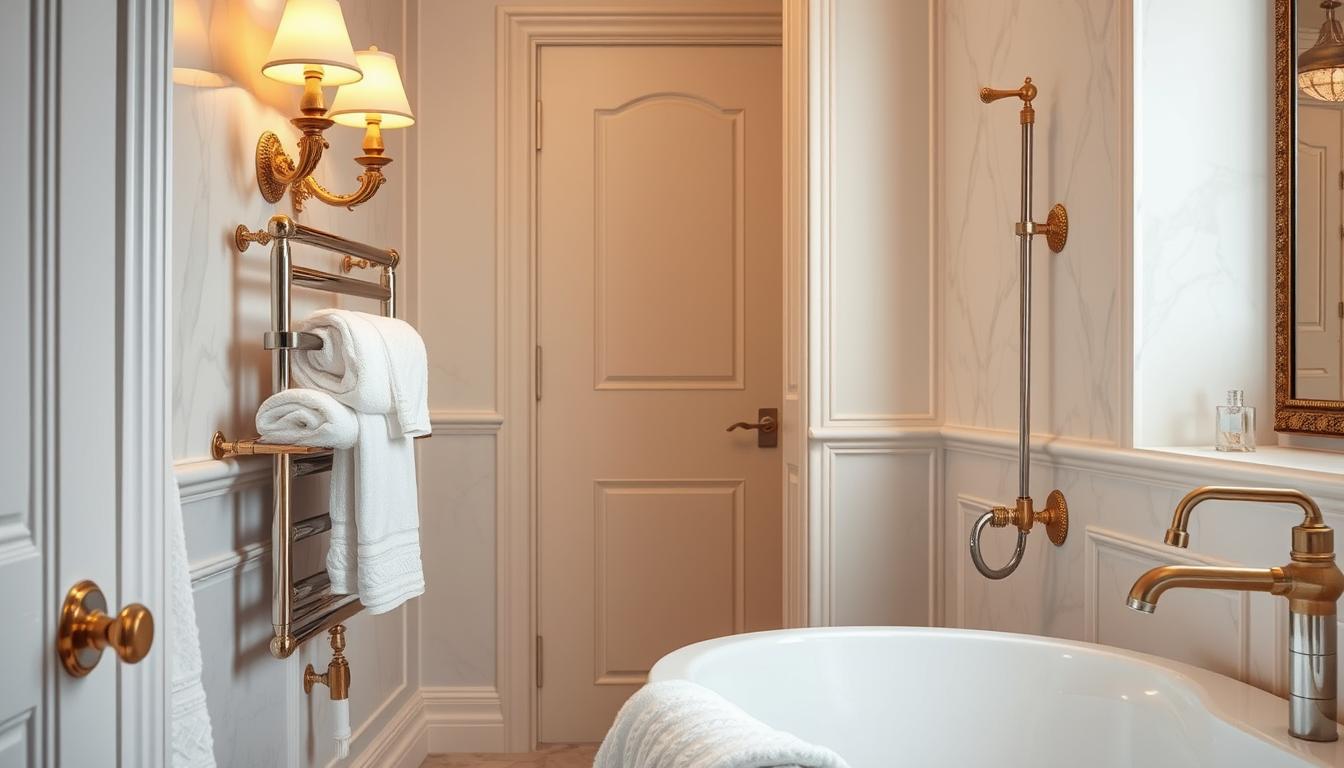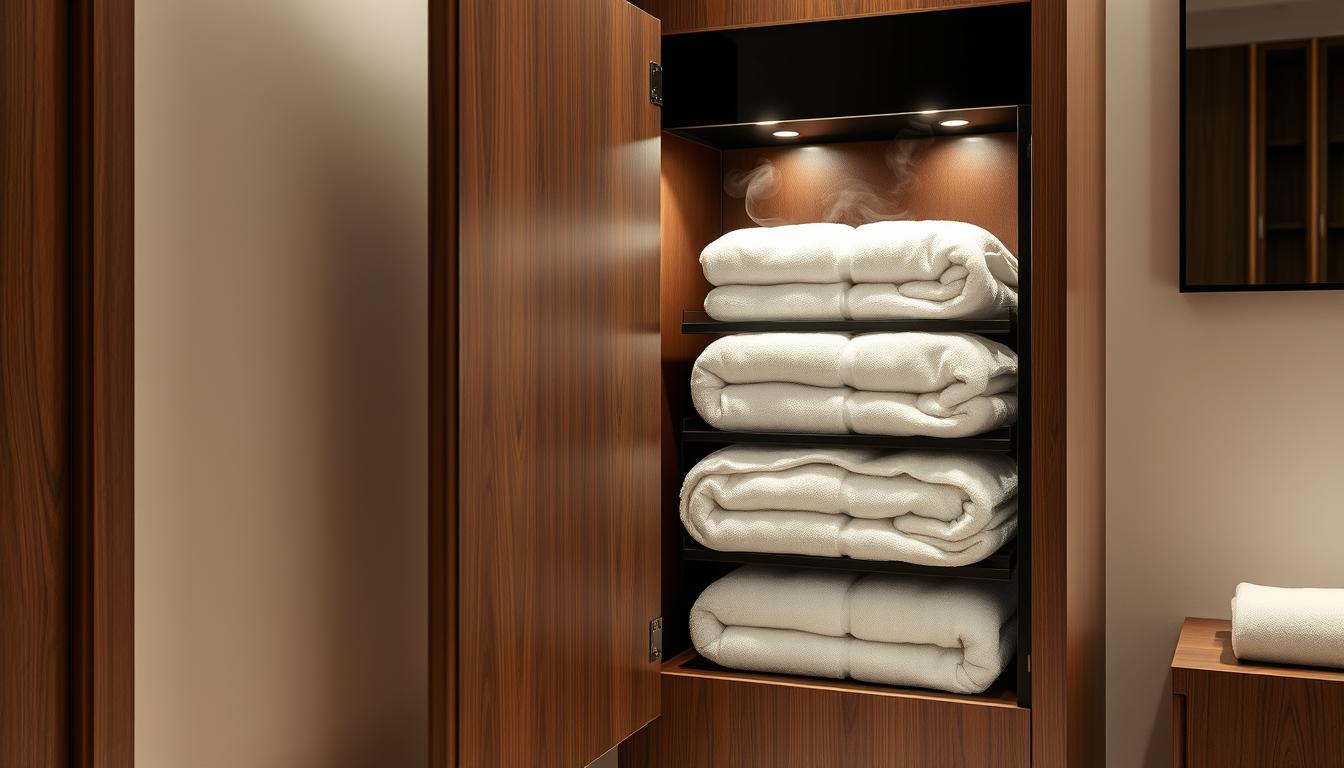Amid the growing quest for superior personal hygiene practices, the bidet is making a splash in bathrooms across the United States. Its purpose is simple yet profoundly impactful: to provide a gentle and thorough clean after using the toilet. The bidet function, rooted in a seamless blend of plumbing innovation and ancient cleansing rituals, enriches daily personal care with its water-based cleaning system. People are realizing the bidet benefits, such as a reduced need for toilet paper, which makes this elegant fixture both a luxurious and eco-conscious choice. With various bidet types, including sleek integrated models or separate units, there’s never been a more opportune moment to upgrade one’s bathroom experience.
Since the dawn of modern bidet plumbing, the technology and design have evolved, ensuring that regardless of your bathroom size or layout, there is a bidet to meet your needs. Whether it’s an attachment to your existing toilet or a stylish standalone unit, integrating a bidet into your home is an investment in wellness, sustainability, and the modern elegance of your bathroom decor.
Key Takeaways
- Bidets offer an enriched cleaning experience, elevating daily personal hygiene standards.
- Eco-friendly and economical, bidets reduce the dependence on toilet paper.
- Diverse bidet types make it easy to incorporate this facility into any bathroom design.
- Understanding bidet plumbing is key to choosing the right model for your home.
- The comfort and bidet benefits extend beyond cleanliness to potential health improvements.
- Modern bidets blend high-tech features with traditional elegance for a luxurious bathroom upgrade.
The History and Evolution of the Bidet
The bidet, a fixture famed for its role in personal hygiene, has undergone a remarkable transformation since its inception. Recognized as a cornerstone of refined cleanliness, the bidet has transitioned from a luxury item into a household essential across the globe, influencing bidet installation practices, the popularity of bidet features, and the general approach to bidet usage.
The Origins of Standalone Bidets
Emerging in Europe during the 18th century, the standalone bidet was a signature of aristocratic bathrooms, reflecting an era of elegance and personal care. Early models required a dedicated space, as well as custom plumbing, and often stood regally beside the toilet. This separate basin, equipped with a faucet or hand-pump, facilitated a manual water flow for users to freshen up. It was bidet features like these that marked a period focused on luxurious, yet functional design.
The Modernization of Bidets in Today’s Bathrooms
Advancements in technology and shifting cultural attitudes have led to innovative bidet solutions suitable for modern living spaces. Add-on bidet seats and integrated systems have become increasingly common across Asia and North America, where spatial efficiency drives demand. These contemporary models blend seamlessly into existing toilets, often boasting a suite of advanced features from temperature-controlled water to air-drying functions – all aimed at optimizing bidet usage. The modernization of the bidet reflects an ongoing evolution, balancing intuitive design with the undeniable appeal of sophistication.
| Feature | Standalone Bidet | Modern Bidet |
|---|---|---|
| Installation Requirements | Dedicated space and plumbing | Integration with existing toilets |
| Design Aesthetic | Classical and elegant | Streamlined and modern |
| Functionality | Manual wash | Adjustable settings and features |
| Cultural Popularity | European luxury accent | Global, space-saving solution |
The evolution from standalone basins to sophisticated, integrated units underscores a dynamic history – one that has seen the bidet adapt to changing lifestyles without losing its core purpose: to offer a hygienic, comfortable, and refined bathroom experience.
Bidet How Does It Work: The Basics of Bidet Functionality
Exploring the fundamentals of bidet usage, it’s essential to comprehend how these fixtures enhance bathroom hygiene. Bidets typically operate by propelling a regulated water stream towards the genital or anal regions to facilitate thorough cleaning. Standalone bidets often require manual positioning to align oneself with the jet, coupled with manual control over the water flow and temperature.
In contrast, bidet cleaning with contemporary models showcases a more user-friendly approach. Easier, seated operation allows users to adjust features such as water pressure and temperature, often through conveniently located controls or remote devices. This hands-off cleaning experience maximizes comfort and efficiency, promoting a soothing yet effective cleansing process.
Modern bidets and attachments, seamlessly integrating into toilet designs, frequently offer an array of adjustable features tailored to individual comfort and preferences:
- Variable water pressure settings
- Temperature controls for a customized experience
- Directional nozzles for precise cleaning
These features not only personalize the bidet usage but also facilitate a more eco-friendly approach to personal care.
Below is an overview of the basic operations across different bidet types:
| Feature | Standalone Bidet | Modern Bidet Attachment |
|---|---|---|
| User Positioning | Manual alignment required | Seated use |
| Water Controls | Manual dials or faucets | Remote or side panel |
| Temperature Adjustment | Typically manual | Often automatic with presets |
| Cleaning Process | User engagement necessary | Hands-off, adjustable settings |
In conclusion, both standalone and modern bidet systems offer distinct modes of operation that cater to varying levels of convenience and comfort, redefining the essential bathroom experience through smart design and innovative technology.
Benefits of Using a Bidet Over Traditional Methods
The transition to using a bidet offers a multitude of advantages, fostering not only personal well-being but also contributing to environmental conservation. Bidet features cater to a seamless hygienic experience, making it an essential bathroom upgrade.
Enhanced Personal Hygiene and Comfort
Bidets are increasingly acknowledged for their role in promoting personal hygiene and comfort. With the ability to thoroughly cleanse without the friction and potential irritation of toilet paper, bidets represent a significant leap in terms of bathroom experience. In particular, bidet benefits are notable for individuals with sensitive skin or those who require extra care, such as elderly individuals or women during postpartum recovery.
Environmental Benefits: Reducing Toilet Paper Waste
Amid growing environmental concerns, an eco-friendly bathroom with a bidet stands as a testament to sustainability. The reduction in toilet paper usage directly translates to fewer trees being felled for paper production, and a diminished burden on water resources, as the paper manufacturing process is water-intensive. By embracing the bidet, households can significantly decrease their ecological footprint.
Health Benefits: Aiding in Issues Such as Hemorrhoids
The gentle cleansing action of a bidet is not only more comfortable than abrasive toilet paper but also advantageous for health reasons. Individuals suffering from conditions like hemorrhoids or anal fissures can find solace in the soothing touch of water compared to the painful experience of traditional wiping methods. The bidet’s adjustable water pressure and temperature features ensure that comfort does not come at the expense of effectiveness.
| Bidet Feature | Health Benefit | Environment Benefit |
|---|---|---|
| Adjustable Water Temperature | Comfort for sensitive skin | Reduces reliance on paper production |
| Adjustable Water Pressure | Effective cleansing for hygiene maintenance | Conserves resources by minimizing waste |
| Hands-free operation | Prevention of bacteria spread | Energy-efficient, lowering overall household consumption |
Diverse Types of Bidets and Their Features
Exploring the variety of bidet types available today shows a significant evolution from their traditional forms. This section delves into the key features of standalone bidets, bidet toilet seats, and non-electric add-on bidets to help you understand the functionality and elegance each type brings to modern bathrooms.
Standalone Bidets: Elegance and Style in Separate Fixtures
Standalone bidets are synonymous with classic bathroom elegance. These fixtures command their own space in the bathroom and are often seen as a statement of luxury. Standalone bidets require independent plumbing and installation, making them a more permanent and traditionally-inclined option.

Bidet Toilet Seats: Convenience and Luxury Combined
Bidet toilet seats are a marvel of modern bathroom technology, combining convenience with luxury. These seats replace your traditional toilet’s seat and lid and come equipped with an array of bidet features such as adjustable water temperature, pressure controls, and even air dryers for a hands-free, hygienic experience.
Non-Electric Add-On Bidets: Accessibility and Simplicity
For those seeking a touch of simplicity and affordability, non-electric add-on bidets offer an excellent introduction to the world of bidets. These add-ons can range from under-seat attachments that harness the water supply of the existing toilet to handheld sprayers that provide a more manual but equally effective clean.
| Bidet Type | Main Feature | Installation Requirements | Typical Usage |
|---|---|---|---|
| Standalone Bidet | Elegant design, separate fixture | Independent plumbing | Next to the toilet, with dedicated space |
| Bidet Toilet Seat | Heated seat, warm water, air dryer | Replaces existing toilet seat, may require electricity | Integrated into the toilet for streamlined use |
| Non-Electric Add-On | Affordable, simple to use | No electricity needed, hooks onto existing plumbing | Easy retrofit option for standard toilets |
In understanding the different bidet types and their respective bidet features, potential buyers can make an informed decision to choose the option that best fits their preferences, whether they desire the elegance of a standalone bidet, the high-tech luxury of a bidet toilet seat, or the straightforward convenience of a non-electric add-on bidet.
Installing a Bidet: What You Need to Know
Embarking on a bidet installation journey can greatly enhance the comfort and hygiene in your bathroom. Whether you opt for a sophisticated bidet toilet seat or a more straightforward non-electric bidet attachment, the installation process is an essential step to ensuring long-lasting efficiency and functionality. It’s important to recognize that while professional installation may be necessary for certain types of bidets, there are many models on the market designed for DIY bidet installation, allowing for a seamless integration with existing bidet plumbing.
The Essentials of Bidet Installation
To get started, understanding the basics of bidet installation is key. A successful setup begins with the identification of water supply lines and the availability of an electrical outlet if you’re installing an electric bidet seat. The correct tools and a thoughtful review of the manufacturer’s instructions will pave the way for a smooth installation process.
Professional Installation vs. DIY: Weighing Your Options
While some homeowners may prefer the reassurance of professional installation, particularly for more complex standalone bidet models, others may find the DIY route both achievable and gratifying. Bidet attachments and toilet seat models typically require minimal plumbing skills, and often just a wrench and a screwdriver will suffice to complete the task. Regardless of which route you choose, ensuring that the bidet is installed correctly is imperative for its proper functioning and your ultimate satisfaction.
| Installation Type | Recommended For | Tools Required | Time Commitment |
|---|---|---|---|
| Professional | Standalone Bidets, Complex Setups | Varies by Professional | 1-2 Hours |
| DIY | Bidet Toilet Seats, Non-Electric Attachments | Wrench, Screwdriver, Teflon Tape | 30-60 Minutes |
Regardless of the method you choose for your bidet installation, having a comprehensive understanding of the process and preparing accordingly can make all the difference in ensuring a positive outcome. With the right preparation, you can enjoy the enhanced hygiene and comfort a bidet brings to your daily routine.
Bidet Usage: How to Operate Different Types of Bidets
Becoming acquainted with bidet usage is essential for those looking to introduce this hygienic practice into their daily routine. The process is simple, although it varies slightly depending on whether you are using a standalone bidet or a modern bidet attachment. Here’s a succinct guide to help beginners and seasoned users alike get the most out of their bidets.

Standalone Bidets: These fixtures typically resemble a low sink and are separate from the toilet. To use, you simply sit or straddle the rim. After toilet use, you move to the bidet, adjust the water temperature and pressure to your comfort, and clean yourself. Hands-free operation isn’t a feature here, so it’s important to pat dry with a towel afterwards.
Modern Bidet Attachments and Seats: These devices have revolutionized bidet function with advanced features. They are attached directly to your existing toilet, enabling a convenient and efficient cleaning experience. Operation typically involves the push of a button or turning a dial to release a spray of water. Temperature, pressure, and angle are often adjustable for a personalized clean.
- Handheld Sprayers: Require manual operation, offering a directed spray for precise cleaning.
- Add-on Bidets: Attach beneath your existing toilet seat and usually include knobs or levers to adjust water temperature and pressure.
- Bidet Toilet Seats: Offer the most sophisticated experience with features such as heated seats, warm water, and even air dryers, controlled usually by a side panel or remote.
Remember, the key aspects to pay attention to, regardless of the type, include the nozzle functionality, the water pressure, and the temperature settings. These factors ensure the bidet’s effectiveness in maintaining personal hygiene.
Using a bidet is not just about improved hygiene; it’s about embracing an eco-friendly lifestyle while enhancing personal comfort.
For the eco-conscious, transitioning to bidet usage can mean a substantial reduction in toilet paper use, lessening the environmental impact. Thus, familiarizing oneself with the functions and operations of various types of bidets isn’t just a personal benefit but a step towards a greener lifestyle.
Bidet Maintenance and Cleaning
Maintaining the impeccable functionality of your bidet not only ensures ongoing hygiene but also extends the durability of the fixture. Proper bidet cleaning and bidet maintenance are integral to the performance and longevity of your unit. Whether your bathroom is equipped with the latest model or a more traditional setup, the consistent upkeep of this sanitary device cannot be overlooked.
Regular Cleaning for Optimal Hygiene
Regular cleaning is quintessential for maintaining the hygienic benefits of a bidet. It’s recommended to clean the nozzle, seat, and other parts of the bidet after each use with a gentle, non-abrasive cleaner. This not only prevents the buildup of bacteria and lime but also preserves the integrity of the bidet’s surfaces.
- Wipe the nozzle with a soft, damp cloth and a mild disinfectant.
- Clean the seat and lid by using a damp cloth and a mild bathroom cleaner.
- Dry all surfaces with a clean, dry cloth to prevent water spots and preserve the finish.
Addressing Common Bidet Issues and Troubleshooting
Even with meticulous maintenance, bidet users may occasionally encounter issues such as clogs or inconsistent water pressure. In such scenarios, consulting the manufacturer’s guidelines can provide swift solutions for common problems.
- Check the owner’s manual for troubleshooting steps relevant to your model.
- Inspect the nozzle for any debris that may cause clogging and clean it accordingly.
- If water pressure is an issue, verify the settings on your bidet and adjust them as necessary.
Regularly scheduled maintenance and immediate attention to issues assure that your bidet is not only clean but also operates without hitch, providing a refreshing experience with each use.
Selecting the Right Bidet for Your Home
Embarking on the quest for the perfect bidet requires a thoughtful examination of your bathroom’s dimensions and design. With a plethora of bidet types available in the market, homeowners must prioritize matching their personal needs with the available bathroom space. Whether opting for a luxurious standalone bidet or a sleek integrated bidet toilet seat, the configuration of your restroom will dictate the most suitable option. Thoughtful consideration of these spatial requirements is the first critical step towards a sophisticated and seamless bidet installation.
Assessing Bathroom Space and Layout
The layout of your bathroom often influences the bidet benefits you can enjoy. A standalone bidet, for instance, beckons with its aura of exclusivity but demands substantial real estate and a dedicated plumbing system. Meanwhile, the ever-popular bidet toilet seat or the simpler add-on bidets, are designed to blend with the contours of your existing toilet, proving to be a more space-efficient alternative. By carefully measuring and planning, homeowners can avoid the pitfalls of an incompatible purchase, ensuring every inch of bathroom space is used to its maximum potential.
Comparing Functionalities: Finding Your Perfect Match
Delving beyond mere aesthetics, exploring the advanced functionalities of different bidet models is paramount. The modern market offers bidet types that vary, from the basic to those brimming with features like adjustable nozzles, warm water streams, and air drying facilities for an unrivaled post-evacuation experience. The cost-benefit analysis of these enhancements should be meticulously conducted. Homeowners should align their personal hygiene preferences with the functional offerings of each bidet model, ensuring the decision is not only driven by cost but also by the promise of a heightened level of comfort and personal care.


